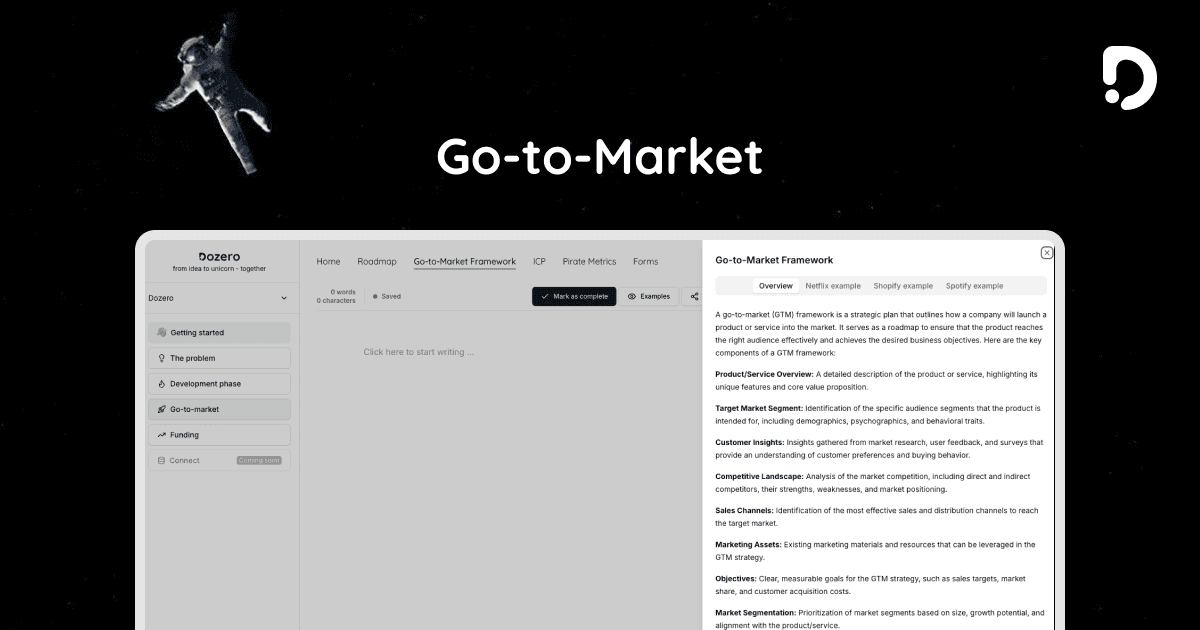< Back
Go-to-Market
Ideal Customer Profile
Nov 6, 2024
An Ideal Customer Profile (ICP) is a detailed description of the type of company that would benefit the most from your product or service and is most likely to become a high-value customer. It serves as a strategic tool for businesses to identify and target their most promising customer segments. An ICP typically includes the following elements:
Business Demographics: Information about the size, industry, location, and revenue of the target businesses. This helps in understanding the market segment that aligns best with your offerings.
Decision-Maker Characteristics: Details about the roles, responsibilities, and pain points of the individuals within these businesses who make purchasing decisions. This helps in tailoring marketing messages and sales approaches to resonate with these key individuals.
Technological Maturity: An assessment of the level of technological adoption and innovation within the target businesses. This includes their openness to new solutions and how they integrate technology into their operations.
Operational Needs: Identification of specific operational challenges or goals that your product/service can address. This could range from improving efficiency to scaling operations or enhancing security.
Values and Goals: An outline of the core values and long-term objectives that drive these businesses. This helps in aligning your product/service with their aspirations and strategic goals.
The ICP is used to guide marketing strategies, sales efforts, and product development, ensuring that resources are focused on the most lucrative opportunities. By understanding the characteristics of the ideal customer, businesses can tailor their offerings and communication to better meet the needs and preferences of these key prospects, ultimately driving growth and customer satisfaction.
Netflix example
Business Demographics:
Size: Individual consumers and households.
Location: Global, with a focus on regions with high internet penetration and streaming capabilities.
Revenue: Not applicable as Netflix targets individual consumers rather than businesses.
Decision-Maker Characteristics:
Roles: Individuals or families who make entertainment decisions for their household.
Responsibilities: Choosing content that suits the preferences of all household members.
Pain Points: Limited access to diverse content, high costs of traditional cable, and the inconvenience of scheduled programming.
Technological Maturity:
Level of Adoption: High. Customers are comfortable using digital platforms and streaming services.
Innovation: Interested in personalized content recommendations and high-quality streaming experiences.
Operational Needs:
Challenges: Finding a wide variety of content that appeals to different tastes and age groups.
Goals: To have easy access to a vast library of movies, series, and documentaries that can be watched on-demand.
Values and Goals:
Core Values: Convenience, variety, and affordability.
Long-term Objectives: To enjoy a seamless entertainment experience that fits their lifestyle and preferences.
Shopify example
Business Demographics:
Size: Small to medium-sized businesses, including startups and individual entrepreneurs.
Industry: E-commerce, retail, and any business looking to establish an online presence.
Location: Global, with a focus on regions with growing e-commerce markets.
Decision-Maker Characteristics:
Roles: Business owners, entrepreneurs, and e-commerce managers.
Responsibilities: Managing online sales, inventory, and customer engagement.
Pain Points: Limited technical expertise, high costs of setting up an online store, and the need for scalable solutions.
Technological Maturity:
Level of Adoption: Moderate to high. Customers are looking for user-friendly platforms that require minimal technical skills.
Innovation: Interested in tools that enhance online sales, such as integrated payment systems and marketing automation.
Operational Needs:
Challenges: Setting up and managing an online store efficiently, driving traffic, and converting visitors into customers.
Goals: To increase online sales, expand market reach, and streamline operations.
Values and Goals:
Core Values: Simplicity, scalability, and support.
Long-term Objectives: To grow their business by leveraging e-commerce opportunities and maintaining a competitive edge.
Spotify example
Business Demographics:
Size: Individual consumers and music enthusiasts.
Location: Global, with a focus on regions with high smartphone and internet usage.
Revenue: Not applicable as Spotify targets individual consumers.
Decision-Maker Characteristics:
Roles: Individuals who are passionate about music and audio content.
Responsibilities: Curating personal playlists and discovering new music.
Pain Points: Limited access to diverse music libraries, high costs of purchasing music, and the inconvenience of managing physical media.
Technological Maturity:
Level of Adoption: High. Customers are comfortable using digital platforms and streaming services.
Innovation: Interested in personalized music recommendations and high-quality audio experiences.
Operational Needs:
Challenges: Discovering new music and managing personal music libraries.
Goals: To have access to a vast library of music and podcasts that can be streamed on-demand.
Values and Goals:
Core Values: Variety, personalization, and accessibility.
Long-term Objectives: To enjoy a seamless and personalized music experience that fits their lifestyle and preferences.

